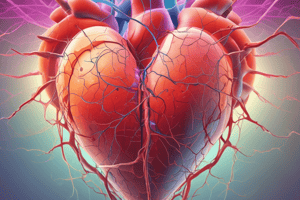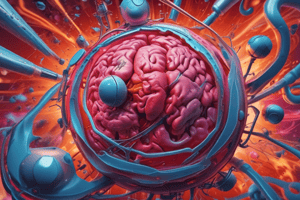Podcast
Questions and Answers
What is the underlying cause of shock?
What is the underlying cause of shock?
- Normal cellular metabolism
- Inadequate blood supply or circulatory failure (correct)
- Increased oxygen supply to tissues
- Excessive blood volume
Aerobic metabolism involves the breakdown of glucose to produce energy without oxygen.
Aerobic metabolism involves the breakdown of glucose to produce energy without oxygen.
False (B)
What is the primary goal of initial management in hypovolemic shock?
What is the primary goal of initial management in hypovolemic shock?
replenishing intravascular volume and limiting further fluid loss
In distributive shock, widespread vasodilation leads to a loss of vascular tone and ______ blood vessels, resulting in a volume shift.
In distributive shock, widespread vasodilation leads to a loss of vascular tone and ______ blood vessels, resulting in a volume shift.
Match the stage of shock with its description:
Match the stage of shock with its description:
Which of the following is NOT a compensatory mechanism activated during the non-progressive stage of shock?
Which of the following is NOT a compensatory mechanism activated during the non-progressive stage of shock?
Medical intervention is typically ineffective in correcting shock during the irreversible/refractory stage.
Medical intervention is typically ineffective in correcting shock during the irreversible/refractory stage.
List three potential causes of hypovolemic shock.
List three potential causes of hypovolemic shock.
In anaphylactic shock, exposure to an allergen leads to the release of chemical mediators, resulting in vasodilation, capillary leakage, and ______.
In anaphylactic shock, exposure to an allergen leads to the release of chemical mediators, resulting in vasodilation, capillary leakage, and ______.
Match the type of distributive shock with its primary cause:
Match the type of distributive shock with its primary cause:
Which of the following signs and symptoms is LEAST likely to be present in a patient experiencing neurogenic shock?
Which of the following signs and symptoms is LEAST likely to be present in a patient experiencing neurogenic shock?
Administering a hypertonic solution will cause water to move from the intravascular space into the cells and interstitial space.
Administering a hypertonic solution will cause water to move from the intravascular space into the cells and interstitial space.
Explain why 5% glucose solutions should be avoided in patients at risk for increased intracranial pressure.
Explain why 5% glucose solutions should be avoided in patients at risk for increased intracranial pressure.
In the context of IV fluid therapy, a ______ solution has the same tonicity as blood and causes minimal fluid shifts.
In the context of IV fluid therapy, a ______ solution has the same tonicity as blood and causes minimal fluid shifts.
Match the intravenous fluid type with its effect on fluid balance:
Match the intravenous fluid type with its effect on fluid balance:
A patient in shock requires fluid resuscitation. Following the initial 250ml bolus, which assessment is MOST critical in guiding further fluid administration?
A patient in shock requires fluid resuscitation. Following the initial 250ml bolus, which assessment is MOST critical in guiding further fluid administration?
Skin turgor is a highly reliable indicator of dehydration in elderly patients.
Skin turgor is a highly reliable indicator of dehydration in elderly patients.
Besides IV fluids, name three non-pharmacological interventions that should be considered in the initial management of shock?
Besides IV fluids, name three non-pharmacological interventions that should be considered in the initial management of shock?
In cases of tension pneumothorax causing obstructive shock, administering IV fluids before ______ can be counterproductive.
In cases of tension pneumothorax causing obstructive shock, administering IV fluids before ______ can be counterproductive.
Match the sign/symptom with the type of shock it is most associated with, beyond the general ones:
Match the sign/symptom with the type of shock it is most associated with, beyond the general ones:
Why is it imperative to control haemorrhage before or concurrently with administering IV fluids in a patient with traumatic cardiac arrest?
Why is it imperative to control haemorrhage before or concurrently with administering IV fluids in a patient with traumatic cardiac arrest?
Unbalanced crystalloid solutions, such as 0.9% saline, are generally considered chemically identical to blood and therefore the preferred choice in pre-hospital shock resuscitation.
Unbalanced crystalloid solutions, such as 0.9% saline, are generally considered chemically identical to blood and therefore the preferred choice in pre-hospital shock resuscitation.
Explain the physiological rationale for elevating a patient's legs as a non-pharmacological intervention for shock.
Explain the physiological rationale for elevating a patient's legs as a non-pharmacological intervention for shock.
The presence of oliguria, defined as the production of abnormally ______ amounts of urine, is a common sign and symptom of shock.
The presence of oliguria, defined as the production of abnormally ______ amounts of urine, is a common sign and symptom of shock.
A patient with known heart failure presents with cardiogenic shock. What type of IV fluid should be administered cautiously, if at all?
A patient with known heart failure presents with cardiogenic shock. What type of IV fluid should be administered cautiously, if at all?
In the acute management of septic shock, the evidence suggests that prompt administration of IV fluids is more important than controlling the source of infection.
In the acute management of septic shock, the evidence suggests that prompt administration of IV fluids is more important than controlling the source of infection.
Describe why administering large volumes of hypotonic IV solutions should be avoided in patients at risk for increased intracranial pressure. What does it cause and why is this harmful?
Describe why administering large volumes of hypotonic IV solutions should be avoided in patients at risk for increased intracranial pressure. What does it cause and why is this harmful?
Neurogenic shock can occur due to spinal cord injury above the level of ______, leading to disruption of sympathetic tone.
Neurogenic shock can occur due to spinal cord injury above the level of ______, leading to disruption of sympathetic tone.
In a patient with anaphylactic shock, after administering epinephrine, what is the next most crucial intervention?
In a patient with anaphylactic shock, after administering epinephrine, what is the next most crucial intervention?
The primary goal of administering vasopressors in shock is to increase cardiac contractility and thereby improve cardiac output.
The primary goal of administering vasopressors in shock is to increase cardiac contractility and thereby improve cardiac output.
Flashcards
Shock
Shock
A life-threatening condition resulting from inadequate blood supply, leading to decreased perfusion and hypoxia in cells and tissues.
Aerobic Metabolism
Aerobic Metabolism
The process of converting oxygen into energy for use in the body.
Anaerobic Metabolism
Anaerobic Metabolism
Producing energy via glycolysis (breakdown of glucose) without oxygen.
Non-Progressive/Compensatory Shock
Non-Progressive/Compensatory Shock
Signup and view all the flashcards
Progressive/Decompensatory Shock
Progressive/Decompensatory Shock
Signup and view all the flashcards
Irreversible/Refractory Shock
Irreversible/Refractory Shock
Signup and view all the flashcards
Hypovolaemic Shock
Hypovolaemic Shock
Signup and view all the flashcards
Cardiogenic Shock
Cardiogenic Shock
Signup and view all the flashcards
Obstructive Shock
Obstructive Shock
Signup and view all the flashcards
Distributive Shock
Distributive Shock
Signup and view all the flashcards
Septic Shock
Septic Shock
Signup and view all the flashcards
Anaphylactic Shock
Anaphylactic Shock
Signup and view all the flashcards
Neurogenic Shock
Neurogenic Shock
Signup and view all the flashcards
Hypotension
Hypotension
Signup and view all the flashcards
Hypoxia
Hypoxia
Signup and view all the flashcards
Oliguria
Oliguria
Signup and view all the flashcards
Tachypnoea
Tachypnoea
Signup and view all the flashcards
Bradypnoea
Bradypnoea
Signup and view all the flashcards
Elevate the legs
Elevate the legs
Signup and view all the flashcards
Hypertonic Solution
Hypertonic Solution
Signup and view all the flashcards
Hypotonic Solution
Hypotonic Solution
Signup and view all the flashcards
Isotonic Solution
Isotonic Solution
Signup and view all the flashcards
Balanced IV Solution
Balanced IV Solution
Signup and view all the flashcards
Unbalanced IV Solution
Unbalanced IV Solution
Signup and view all the flashcards
Skin Turgor
Skin Turgor
Signup and view all the flashcards
Non-Shock fluid replacement
Non-Shock fluid replacement
Signup and view all the flashcards
Shock fluid replacement
Shock fluid replacement
Signup and view all the flashcards
Study Notes
- Shock is a life-threatening condition arising from inadequate blood supply or circulatory failure, leading to decreased perfusion and hypoxia in cells and tissues.
- Early recognition is crucial as shock can lead to irreversible cell damage, multiorgan failure, and death.
- Initial stage involves decreased blood flow.
Three Stages of Shock
- Non-progressive/Compensatory Shock
- Progressive/Decompensatory Shock
- Irreversible/Refractory Shock
Stage 1 - Non-Progressive/Compensatory Shock
- Compensatory mechanisms activate in response to changes that challenge homeostasis.
- Decreased blood flow activates the sympathetic nervous system, renin-angiotensin system, and hormone release (adrenaline, antidiuretic hormone).
- Mechanisms include tachypnoea, tachycardia, peripheral vasoconstriction, increased cardiac contractile strength, and fluid retention by the kidneys.
Stage 2 - Progressive/Decompensatory Shock
- Compensatory mechanisms fail due to rapid shock progression or fatigue.
- Leads to tissue damage, systemic acidosis, and decreased function of cardiac, renal, and pulmonary systems.
- Medical intervention can still be effective.
Stage 3 - Irreversible/Refractory Shock
- Cell and tissue damage becomes irreversible.
- Organ dysfunction and failure occur.
- Medical intervention becomes ineffective.
- Death is the most likely outcome.
Types of Shock
- Hypovolaemic
- Cardiogenic
- Obstructive
- Distributive (Septic, Anaphylactic, Neurogenic)
Hypovolaemic Shock
- Occurs from a decrease in intravascular blood or fluid volume.
- Decreased stroke volume leads to decreased cardiac output and blood pressure.
- Haemorrhagic causes include trauma and internal bleeding.
- Non-haemorrhagic causes include burns, renal failure, and vomiting/diarrhoea.
- Management aims to limit further fluid loss and replenish intravascular volume.
Cardiogenic Shock
- Occurs due to impaired cardiac function, leading to decreased cardiac output.
- Causes include cardiomyopathies, dysrhythmias, and mechanical issues.
Obstructive Shock
- Occurs due to an obstruction impeding blood flow in great vessels or the heart.
- Causes include tension pneumothorax, cardiac tamponade, and pulmonary embolism.
Distributive Shock
- Occurs due to maldistribution of intravascular volume, resulting in relative hypovolaemia.
- Widespread vasodilation results in loss of vascular tone and leaky blood vessels, shifting volume from the intravascular to the interstitial space.
Septic Shock (Distributive)
- Due to a dysregulated response to infection, leading to systemic inflammation and organ dysfunction.
- Caused by infections where the pathogen enters the bloodstream.
Anaphylactic Shock (Distributive)
- Due to exposure to an allergen, leading to rapid release of chemical mediators.
- Symptoms include vasodilation, capillary leakage, angioedema, and bronchospasm.
- Allergens include medications (antibiotics, NSAIDs), insect bites/stings, and foods (nuts, shellfish).
Neurogenic Shock (Distributive)
- Due to damage to the spinal cord or brain, impairing nervous system and sympathetic tone regulation.
- Symptoms include vasodilation and bradycardia.
- Causes include spinal cord injury above T6, spinal anaesthesia, and spinal neuropathies like Guillain-Barre syndrome.
Signs and Symptoms of Shock
- Hypotension
- Hypoxia
- Altered level of consciousness or confusion
- Oliguria (abnormally small amounts of urine)
- Dysrhythmias (tachycardia, bradycardia in neurogenic)
- Respirations (tachypnoea, bradypnoea in neurogenic)
- Skin/temperature changes (cool, clammy, mottled skin; warm, flushed skin in septic shock; fever with rigours in septic shock)
- Chest pain and pulmonary oedema in cardiogenic shock
- Dry mucous membranes in hypovolaemic shock
- Distended jugular veins in obstructive shock
- Urticaria, angioedema, wheezing, or muffled lung sounds in anaphylaxis
Pharmacological Shock Treatment
- Oxygen therapy
- IV fluid replacement (balanced crystalloids like Hartmann's or normal saline)
- Blood product replacement
- IV antibiotics/antivirals
- Adrenaline, steroids, and antihistamines
- Vasopressors (adrenaline, metaraminol)
- Inotropes (digoxin, dobutamine)
- Anticoagulants/antiplatelets (aspirin)
Non-Pharmacological Shock Treatment
- Elevate the legs
- Maintain warmth (normal or space blanket)
- Continuous monitoring of vital signs
- IV cannulation
- Control bleeding/fluid loss
- ECG
- Ultrasound
- Decompression/thoracostomy
- Pericardiocentesis
- Catheter insertion
- Echocardiogram
- Surgery
Principles of Intravenous Fluid Therapy
Water Balance in a Cell
- Hypertonic solution: Higher concentration outside the cell, fluid moves out, cell shrinks.
- Hypotonic solution: Higher concentration inside the cell, fluid moves in, cell expands.
- Isotonic solution: Equal concentration, no net movement.
- Goal is to increase circulating volume via isotonic solution administration.
IV Fluid Movement In and Out Blood Vessels
- Hypertonic solution increases tonicity and draws water into the intravascular space, increasing blood volume but decreasing interstitial fluid.
- Hypotonic solution decreases tonicity, causing water to move out of the intravascular space into cells and interstitial spaces.
- Isotonic solution has minimal or no movement, increasing volume without shifting fluids.
Balanced vs Unbalanced - Choice of IV Fluid
- Isotonic solutions are generally best for treating shock.
- Balanced solutions (Hartmann's) have a composition similar to blood, while unbalanced solutions (0.9% saline) do not.
- Hartmann's increases intravascular volume without excessive fluid movement.
- Either Hartmann's or 0.9% saline is suitable in the acute resuscitation phase.
Managing IV Lines
- Isotonic solutions (NaCl, Hartmann's, 5% glucose) expand vascular volume.
- Avoid 5% glucose in those at risk for increased intracranial pressure as it can increase cerebral oedema.
- Hypertonic solutions (5% glucose in normal saline, etc.) draw fluid into the vascular space, expanding vascular volume, but should not be administered to people with kidney/heart disease or those that are dehydrated.
- Hypotonic solutions (0.45% NaCl, 0.33% NaCl) provide free water and treat cellular dehydration and promote waste elimination by the kidneys, but should not be administered to those at risk of increased cranial pressure or 3rd space fluid shift.
IV Fluid Preparation and Doses
- Non-shock fluid replacement (NSW): 10mL per kg
- For two or more key signs of shock (NSW): 20mL/kg initial dose, constantly reassess the patient and how they are responding the fluids.
- Full dose is given after repeated observations and reassessments of an individuals response to the incoming fluid
- Start at 5ml/kg and reassess for those who have more weaker compensatory mechanisms.
- Severe shock may need 20ml/kg
- Evaluate response every 250ml
- Septic shock needs approximately 3L in the first few hours
Key Notes on Shock Treatment
- Administering IV fluid is not the solution to most shock states
- Counter shock using BLS interventions, consider correctable causes (e.g. decompression of a tension pneumothorax)
- Address haemorrhage control before or concurrent with IV fluid infusion.
- Monitor the patient receiving fluids or reassessing.
- Fluid administration should be conservative, judicious, and grounded in continual observation and reassessment.
Skin Turgor
- Measures the skin's elasticity; tenting indicates dehydration.
- Appropriate sites: sub-clavicular, abdomen, forearm.
- Cautions: Avoid dorsum of hand, decreased elasticity with increased age, not significant alone.
Studying That Suits You
Use AI to generate personalized quizzes and flashcards to suit your learning preferences.




